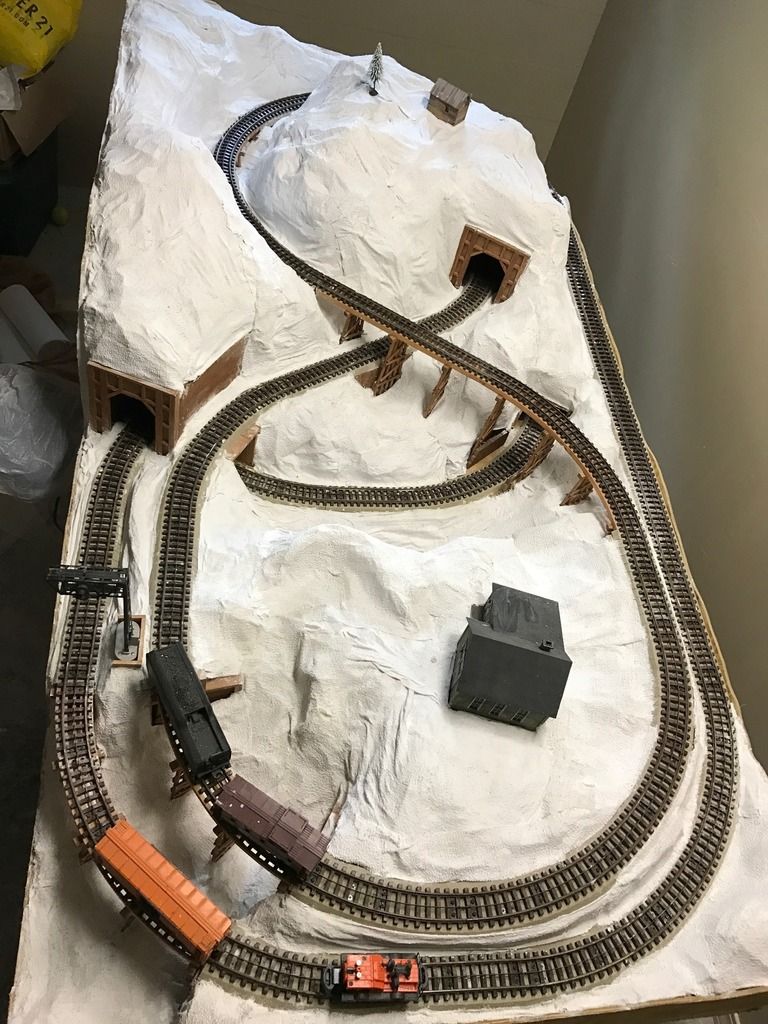On the bright side, I'm very glad that I didn't realize just how big an undertaking this would be, or otherwise I never would have initiated my dream of building a winter train layout.
Working a few hours here & there, this has been many years in the making, and I'm at the stage now where the gauze is done and I need to concentrate only on cosmetics...or so I thought. As I was preparing to begin on a thin layer of plaster that I would smooth over with a wet sponge before it sets up (and then applying some "rock profiles" onto the sheer sides using these cool Woodland Scenics rubber molds), I decided to do test runs with my 681 locomotive along with the various 1950s trains that I am planning to string with it.
Problems.
I got overly ambitious with the design, and as you can see with the 4 tunnel openings, it took quite a bit of engineering to make it all fit on one 4' x 8' plywood sheet. As one particular grade is too steep, I have been aware that the train will only run in one direction. I have also known from previous testing that the ZW(R) transformer must be set between 12.5 and 13 volts: any less than that and the train with cars cannot climb the main grade; any more and the locomotive wipes out on the downward curves. Here is an overhead view:

Though it may be tough to decipher in the photo, the train crosses a "valley" straight across the middle of the photo from left to right. Just before the train comes out of the tunnel, it comes down a 10% grade, and though it didn't seem to be a problem in my earlier tests during fabrication, about 1/2 the time now the 681 flies off the track even at the target 12.5v and into what will be a runoff lake to the right/south. The 681 is simply too heavy, and moreso when pulling a consist of trains.
I realized that I have buried in the back of the closet a beat-up 2036 locomotive that belonged to my dad @1958, and I figured I'd have nothing to lose by giving it a try. The budget locomotive hadn't been fired up since the Reagan administration at very least, but just like a Rudolph-esque christmas miracle, the unwanted ugly stepchild came through to save the day. The 2036 does not wipe out at the aforementioned valley crossing like the 681 does--and the 2036 in fact has a slightly wider voltage range with the ZW(R) transformer--but the problem is that the front wheels tend to pop off the tracks at the same spot:

Coming out of the tunnel to the very left in the above photo of my layout, I had to run two curved sections of track in opposing directions--if I am explaining that well enough--which causes the train to do a slight zig-zag. Though not an issue with the 681, this spot causes the ornamental front wheels on the 2036 to jump off the track almost every time. (The small back wheels of the 2036 will infrequently derail here as well.) I see online that the 2036 is engineered for the slightly narrower O-27 track, but will run on regular O-gauge as well. Is there any way to add resistance to the pivot of the very loose front wheels so that they don't jump off the track? Is there another budget locomotive (nothing new: I'm Chinese-averse when it comes to trains) that's intended for O-gauge that I might want to look for?
Any/all suggestions welcome.
PS-- The MTH motion activator that I have wired to the #452 Lionel signal does not seem to be working: the lights of the signal don't even illuminate. It worked fine when I last tested it 4 months ago! Any ideas?

Though not related to my questions, here is a picture taken from the back corner. There is space between the mountain and the curved bridge, and once I apply the plaster and trees, I will create an ice waterfall here.



